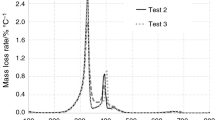Abstract
Flame spread in textile materials was modelled using two different simulation programs: the semi-empirical area-based code ConeTools, and the computational fluid dynamics, CFD, code Fire Dynamics Simulator, FDS, (version 5). Two textile products developed within the EU-project Flexifunbar were selected for study. The two products show a large difference in composition and application area, one material is developed to function as a protecting layer for the underlying structure in case of fire while the other is an insulating material with no requirements on fire performance. The products represent materials for which fire test results indicate a classification on either end of the rating scale for wall materials according to EN 13501. Two FDS-models were developed for the simulations. The first FDS model was a relatively simple model of the small scale Cone Calorimeter test (ISO 5660) which served the purpose of a first preliminary validation of the model for pyrolysis of the material. In the second FDS model, a model of the intermediate scale Single Burning Item, SBI, test method (EN 13823), the fire scenario was expanded to simulate flame spread over a surface. The work included determination of the necessary material properties. In ConeTools, the option to predict an SBI test was used. The results from the two simulation methods were compared to real SBI tests. Neither model was able to fully predict the heat release rate for these complex products. However, the results from both codes were accurate enough to correctly predict the fire rating class for wall linings according to EN13501.









Similar content being viewed by others

References
Saito K, Quintiere JG, Williams FA (1984) Upward turbulent flame spread. In: Proceedings of the first international symposium on fire safety science, Hemisphere Publishing Corporation, NY
Wickström U, Göransson U (1987) “Prediction of Heat Release Rates of Surface materials in Large-Scale Fire Tests Based in Cone Calorimeter Results”, J. Testing and Evaluation, 15: 364-370.
Wade C (April 1996) A room fire model incorporating fire growth on combustible lining materials. Master Thesis, Worcester Polytechnic Institute, Worcester, MA
McGrattan K et al. (2007) Fire dynamics simulator (Version 5) user’s guide. NIST Special Publication, Gaithersburg, 1019-5
Sundström B (2007) The development of a European fire classification system for building products test methods and mathematical modelling. Doctoral Thesis, LUTVDG/TVBB-1035-SE, Lund
Rubini P (2000) “SOFIE Version 3.0 Users guide”. Cranfield University School of Mechanical Engineering, England.
Karlsson B (1992) Modelling fire growth on combustible lining materials in enclosures. PhD thesis TVBB 1009, Lund University, Department of Fire Safety Engineering
van Hees P, Hertzberg T, Steen Hansen A (2002) Development of a screening method for the SBI and room corner using the cone calorimeter. SP Report 11
Messerschmidt B, Van Hees P, Wickström U (1999) Prediction of SBI (single burning item) test results by means of cone calorimeter test results. In: Interflam proceedings. Interscience communication Ltd, London, pp 11–22
McCaffrey B Flame height. In: The SFPE Handbook of Fire Protection Engineering, 2nd edn, Chapter 2–1
EN 13238 (2001) Reaction to fire tests for building products—Conditioning procedures and general rules for selection of substrates
Hjohlman M, Andersson P (2008) Flame spread modelling of textile products. SP Report 2008:34
Andersson J, Persson F (2001) Computer supported simulation of pyrolysis. Diploma paper 01–08, Chalmers Lindholmen University College, Department of Chemical Engineering
Svensson J (2004) “Thermal decomposition of biomass and construction materials – an experimental study”. Göteborg University Department of Chemistry.
Schartel B, Bartolmai M, Knoll U (2005) Some comments on the use of Cone Calorimeter data. Polym Degrad Stab 88(3):540-547
Gustafsson S E, Long T (1995) Transient Plane Source (TPS) “Technique for Measuring Thermal Properties of Building Materials”. Fire and Material. 19: 43-49.
Gustafsson S E (1991) “Transient Plane Source (TPS) Technique for Thermal Conductivity and Thermal Diffusivity Measurements of Solid Materials”. Rev Sci Instrum. 63(3): 797-804.
Mulholland G, Croarkin C (2000) “Specific Extinction of Flame Generated Smoke”. Fire and Materials. 24: 227-230.
The SFPE handbook of fire protection engineering, 3rd edn, (2002).
EN 13501-1 (2002) Fire classification of construction products and building elements—Part 1: classification using data from reaction to fire tests.
Rumbau V, Guillaume E, Sainrat A (2007) EGOLF SBI thermal attack measurements round robin2
Hietaniemi J, Hostikka S, Vaari J (2004) FDS simulation of fire spread—comparison of model results with experimental data
Acknowledgements
The work in this paper was conducted as part of FLEXIFUNBAR contract no. 505864 IP-SME-FP6 which was financially supported by the European commission. The support is gratefully acknowledged.
Author information
Authors and Affiliations
Corresponding author
Rights and permissions
About this article
Cite this article
Hjohlman, M., Andersson, P. & van Hees, P. Flame Spread Modelling of Complex Textile Materials. Fire Technol 47, 85–106 (2011). https://doi.org/10.1007/s10694-009-0128-2
Received:
Accepted:
Published:
Issue Date:
DOI: https://doi.org/10.1007/s10694-009-0128-2



